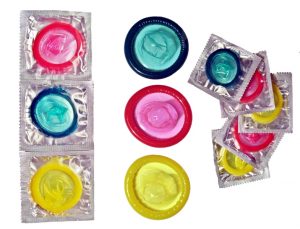Condoms

A male condom is a thin cover (usually made of latex, a type of rubber) worn on the penis. Condoms work by forming a barrier between the penis and anus, vagina, or mouth. The barrier keeps one partner’s fluids from getting into or on the other partner and reduces the amount of skin-to-skin contact. Condoms are typically made of latex, polyisoprene, or polyurethane.
Sheepskin/Lambskin condoms will not prevent the transmission of HIV or other sexually transmitted diseases.
How does it work?
Condoms work by preventing the exchange of fluids between partners. The male condom is placed on a guy’s penis when it becomes erect (and before any sexual contact). It is unrolled all the way to the base of the penis while holding the tip of the condom to leave some extra room at the end. This creates a space for semen after ejaculation and makes it less likely that the condom will break.
After the guy cums (ejaculates), he should hold the condom at the base of the penis as he pulls out of the anus, mouth, or vagina. He should do this while the penis is still erect to prevent the condom from slipping off when he gets soft. If this happens, semen could spill.
Condom Precautions
Once a condom is used, it cannot be reused. A new condom should be used each time you have sex — and it must be used from start to finish every time you have sex. Never use oil-based lubricants such as mineral oil, petroleum jelly, or baby oil with condoms because these substances can break down the rubber. A used condom should be thrown in the garbage, not down the toilet; this prevents clogging of the sewage pipes.
If a condom seems dry, sticky, or stiff when it comes out of the package, or if it is past its expiration date, throw it away and use a new one. It’s a good idea to have several condoms on hand in case there is a problem with one. It’s best to store unused condoms in a cool, dry place.
How do you get it?
Condoms are available without a prescription and are sold in drugstores, supermarkets, and even vending machines (in some stores, they’re in the “Family Planning” aisle). They can also be obtained from some health centers, family planning clinics, and schools. Condoms come in different sizes, textures, and colors.
How much does it cost?
Condoms are the least expensive and most available method of protection — other than abstinence, of course. Male condoms cost about $0.50 to $1 each and are less expensive when they are bought in boxes that contain several condoms. In addition, many health centers, family planning clinics (including Vista Community Clinic) and some schools distribute them free of charge.
Adapted from Teens Health Condom section: http://kidshealth.org/teen/sexual_health/contraception/contraception_condom.html